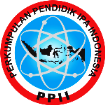Identifying Javanese Students' Conceptions on Fluid Pressure with Wright Map Analysis of Rasch
Abstract
This research aims to identify the conception of Central Javanese students on fluid pressure. The survey was conducted in Central Java involving 515 participants (eight grade students about 14 years old) consisting of 177 males and 338 females. The instrument consists of six questions in a four-tier format about fluid pressure and is distributed via Microsoft Form. The analysis was carried out with Rasch analysis and percentages with six categories of conceptions: CU (Conceptual Understanding); PP (Partial Plus); PM (Partial Minus); NU (No Understanding); MC (Misconception); and NC (No Coding). The Rasch analysis shows the Cronbach alpha is 0.68 (Enough) and the distribution of students' conceptions of fluid pressure forms a normal curve. Meanwhile, bias was not found for gender problems in answering the questions. The percentage of the result are: CU (17%), PP (4%), PM (39%), NU (13%), MC (27%), and NC (0%). This indicates that students' conceptions are still dominated by PM and MC categories. Students in the PM category have good characteristics but lack self-confidence. While the MC category is an unexpected result because students are confident in their answers that are wrong or not in accordance with scientific conceptions. Thus, further action is needed to overcome students' misconceptions.
Keywords: Students' Conceptions, Fluid Pressure, Rasch Analysis
Full Text:
PDFReferences
Adimayuda, R., Aminudin, A. H., Kaniawati, I., Suhendi, E., & Samsudin, A. (2020). A multitier open-ended momentum and impulse (MOMI) instrument: Developing and assessing quality of conception of 11th grade sundanese students with rasch analysis. International Journal of Scientific and Technology Research, 9(2), 4799–4804.
Alavi, S. M., & Bordbar, S. (2016). Differential Item Functioning Analysis of High-Stakes Test in Terms of Gender: A Rasch Model Approach. Malaysian Online Journal of Educational Sciences, 5(1), 10–24.
Aminudin, A. H., Kaniawati, I., Suhendi, E., Samsudin, A., Coştu, B., & Adimayuda, R. (2019). Rasch Analysis of Multitier Open-ended Light-Wave Instrument (MOLWI): Developing and Assessing Second-Years Sundanese-Scholars Alternative Conceptions. Journal for the Education of Gifted Young Scientists, 7(3), 607–629. https://doi.org/10.17478/jegys.574524
Boone, W. J., Staver, J. R., Yale, M. S., Boone, W. J., Staver, J. R., & Yale, M. S. (2014). Person Reliability, Item Reliability, and More. In Rasch Analysis in the Human Sciences (pp. 217–234). https://doi.org/10.1007/978-94-007-6857-4_10
Cahyani, H., Samsudin, A., Tarigan, D. E., Kaniawati, I., Suhendi, E., Suyana, I., Danawan, A., & Karena, A. (2019). Identifikasi miskonsepsi fluida statis pada siswa SMA menggunakan four-tier diagnostic test. Prosiding Seminar Nasional Fisika 5.0, 0, 114–124.
Candra, N., Setiawan, E., & Ilahi, P. R. (2022). Identification of Misconceptions in Chemical Bonding Materials Using Three Tier Diagnostic Test. Journal of Natural Science and Integration, 5(1), 77–89. https://doi.org/10.24014/jnsi.v5i1.16860
Diani, R., Latifah, S., Anggraeni, Y. M., & Fujiani, D. (2018). Physics Learning Based on Virtual Laboratory to Remediate Misconception in Fluid Material. Tadris: Jurnal Keguruan Dan Ilmu Tarbiyah, 3(2), 167. https://doi.org/10.24042/tadris.v3i2.3321
Fraenkel, J. R., & Wallen, N. E. (2009). How to Design and Evaluate Research in Education (M. Ryan (ed.); Seventh). Beth Mejia.
Fratiwi, N. J., Samsudin, A., Ramalis, T. R., Saregar, A., Diani, R., Irwandani, Rasmitadila, & Ravanis, K. (2020). Developing memori on Newton’s laws: For identifying students’ mental models. European Journal of Educational Research, 9(2), 699–708. https://doi.org/10.12973/eu-jer.9.2.699
Gumilar, S. (2016). Analisis Miskonsepsi Konsep Gaya Menggunakan Certainty of Respon Index (CRI). Gravity, 2(1), 59–71. http://jurnal.untirta.ac.id/index.php/Gravity
Haryono, H. E., Aini, K. N., Samsudin, A., & Siahaan, P. (2021). Reducing the students’ misconceptions on the theory of heat through cognitive conflict instruction (CCI). AIP Conference Proceedings, 2330. https://doi.org/10.1063/5.0043400
Jousten, K., Hendricks, J., Barker, D., Douglas, K., Eckel, S., Egan, P., Fedchak, J., Flügge, J., Gaiser, C., Olson, D., Ricker, J., Rubin, T., Sabuga, W., Scherschligt, J., Schödel, R., Sterr, U., Stone, J., & Strouse, G. (2017). Perspectives for a new realization of the pascal by optical methods. Metrologia, 54(6), S146–S161. https://doi.org/10.1088/1681-7575/aa8a4d
Kaltakci-Gurel, D., Eryilmaz, A., & McDermott, L. C. (2017). Development and application of a four-tier test to assess pre-service physics teachers’ misconceptions about geometrical optics. Research in Science and Technological Education, 35(2), 238–260. https://doi.org/10.1080/02635143.2017.1310094
Koto, I., & Gusma, S. E. (2021). Using certainty response index to differentiate lack of knowledge and misconception about basic electrical concepts. Journal of Physics: Conference Series, 1731(1). https://doi.org/10.1088/1742-6596/1731/1/012070
Lestari, A. S., & Samsudin, A. (2020). Using rasch model analysis to analyze students’ scientific literacy on heat and temperature. PervasiveHealth: Pervasive Computing Technologies for Healthcare, 1, 619–626. https://doi.org/10.4108/eai.12-10-2019.2296483
Liu, G., & Fang, N. (2016). Student misconceptions about force and acceleration in physics and engineering mechanics education. International Journal of Engineering Education, 32(1), 19–29.
Lotter, C. R., & Miller, C. (2017). Improving Inquiry Teaching through Reflection on Practice. Research in Science Education, 47(4), 913–942. https://doi.org/10.1007/s11165-016-9533-y
Nurjani, D. M., Alpusari, M., Mahartika, I., Diniya, D., Ilhami, A., Permana, N. D. P., Alim, J. A., Sari, I. K., Mulyani, E. A., Putra, R. A., & Hermita, N. (2020). Identifying the Misconception of Sound Concepts among Grade v Students at SDN 192 Pekanbaru. Journal of Physics: Conference Series, 1655(1). https://doi.org/10.1088/1742-6596/1655/1/012074
Permana, N. D., Wibowo, F. C., Susilawati, Zarkasih, Z., Bakhtiar, N., Darman, D. R., & Siswanto, S. (2021). Development of a Basic Physics Practicum Guide that is Integrated with Qur’anic Verses for Prospective Natural Science Teachers. AIP Conference Proceedings. https://doi.org/10.1063/5.0037559
Ringo, S. ., Kuswanto, K., Samsudin, A., & Setiawan, A. (2021). Rural and urban students’ attitudes toward physics: a comparative study using Rasch analysis. Journal of Physics: Conference Series, 0–6. https://doi.org/10.1088/1742-6596/1806/1/012009
Samsudin, A., Afif, N. F., Nugraha, M. G., Suhandi, A., Fratiwi, N. J., Aminudin, A. H., Adimayuda, R., Linuwih, S., & Costu, B. (2021). Reconstructing Students’ Misconceptions on Work and Energy through the PDEODE*E Tasks with Think-Pair-Share. Journal of Turkish Science Education, 18(1), 118–144. https://doi.org/10.36681/tused.2021.56
Samsudin, A., Aminudin, A. H., & Fratiwi, N. J. (2021). Measuring students ’ conceptions of light waves : A survey in Central Java Measuring students ’ conceptions of light waves : A survey in Central Java. https://doi.org/10.1088/1742-6596/1796/1/012124
Samsudin, A., Cahyani, P. B., Purwanto, Rusdiana, D., Efendi, R., Aminudin, A. H., & Coştu, B. (2021). Development of a multitier open-ended work and energy instrument (MOWEI) using Rasch analysis to identify students’ misconceptions. Cypriot Journal of Educational Sciences, 16(1), 16–31. https://doi.org/10.18844/cjes.v16i1.5504
Samsudin, A., Suhandi, A., Rusdiana, D., Kaniawati, I., & Coştu, B. (2017). Promoting conceptual understanding on magnetic field concept through interactive conceptual instruction (ICI) with PDEODE∗E tasks. Advanced Science Letters, 23(2), 1205–1209. https://doi.org/10.1166/asl.2017.7539
Saputra, O., Setiawan, A., & Rusdiana, D. (2019). Identification of student misconception about static fluid. Journal of Physics: Conference Series, 1157(3). https://doi.org/10.1088/1742-6596/1157/3/032069
Strobl, C., Kopf, J., & Zeileis, A. (2015). Rasch Trees: A New Method for Detecting Differential Item Functioning in the Rasch Model. Psychometrika, 80(2), 289–316. https://doi.org/10.1007/s11336-013-9388-3
Sumintono, B. (2018). Rasch Model Measurements as Tools in Assesment for Learning. 1st International Conference on Education Innovation (ICEI 2017), 38–42. https://doi.org/10.2991/icei-17.2018.11
Wijaya, C. P., Supriyono Koes, H., & Muhardjito. (2016). The diagnosis of senior high school class X MIA B students misconceptions about hydrostatic pressure concept using three-tier. Jurnal Pendidikan IPA Indonesia, 5(1), 14–21. https://doi.org/10.15294/jpii.v5i1.5784
DOI: http://dx.doi.org/10.24014/jnsi.v6i2.21822
Refbacks
- There are currently no refbacks.

Journal of Natural Science and Integration
E-ISSN: 2620-5092 P-ISSN: 2620-4967
Published By:
Department of Science Education, Faculty of Education and Teacher Training,
State Islamic University of Sultan Syarif Kasim Riau, Indonesia
Mailing Address:
Jl. H.R Soebrantas Km. 15 No. 155
Kelurahan Simpang Baru
Kecamatan Tuah Madani, Pekanbaru, Riau, Indonesia
Email: jnsi.tadrisipa@uin-suska.ac.id
Indexed By:
Journal of Natural Science and Integration is licensed under a Creative Commons Attribution 4.0 International License.


_-_Copyy2.png)






.jpg)
.png)
.jpg)
.jpg)




